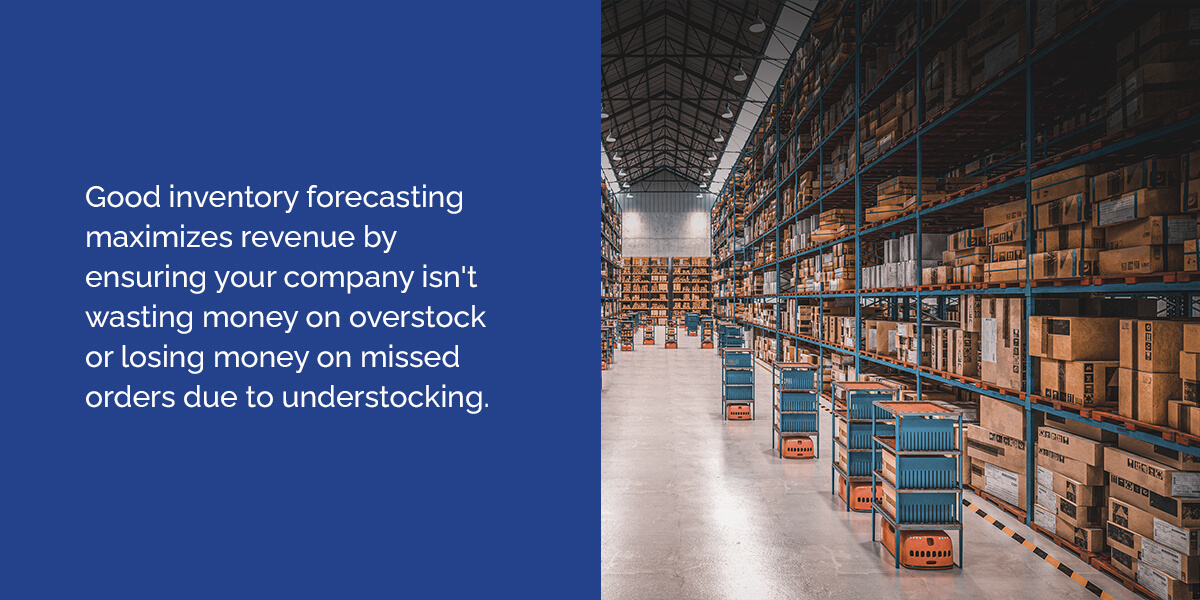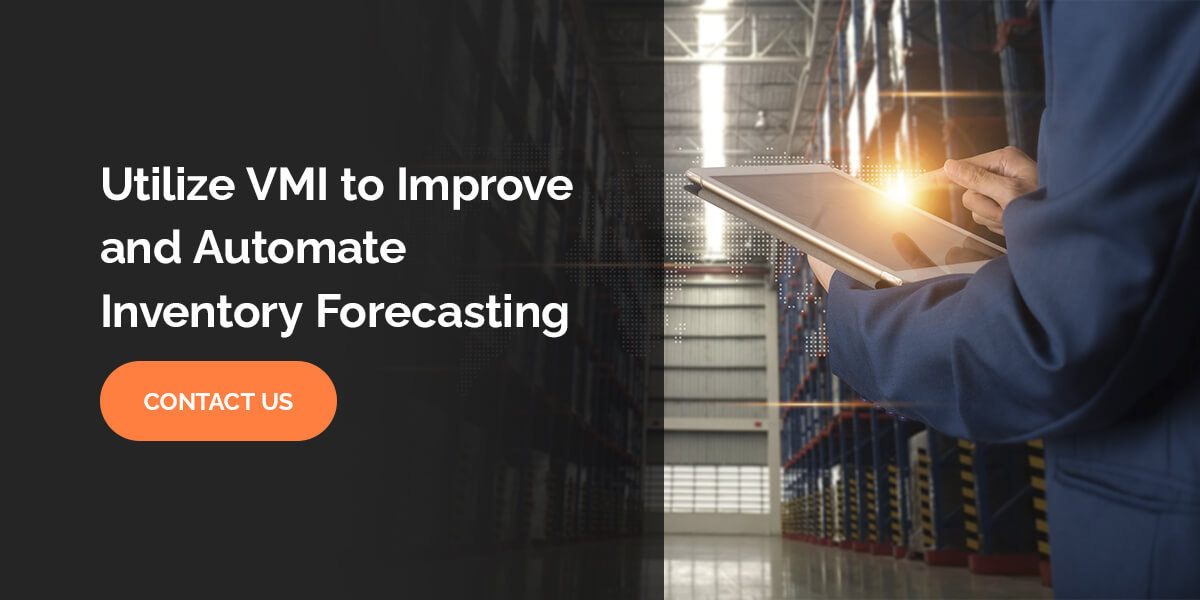Inventory Forecasting: How Automation Can Improve Your Forecasting for Better and Cheaper Inventory Management

January 23, 2023
A company’s ability to forecast demand, plan for fulfillment, and adapt to supply chain disruptions is critical to its success. Poor inventory management can lead to overstocking and understocking and disappointed customers. As supply chains evolve with customer demands and expand globally, antiquated and manual inventory forecasting methods can’t keep up with business needs.
Many supply chain managers are already adjusting to the need for better inventory management. A McKinsey survey found that four out of five supply chain leaders plan to or already use machine learning and artificial intelligence (AI) to enable greater agility as supply chain needs change. Utilizing automation can significantly improve inventory forecasting in the supply chain and optimize your company’s supply chain management strategy.
The Purpose and Importance of Inventory Forecasting
Inventory forecasting does more than keep your company on top of inventory replenishment. Forecasting inventory effectively helps businesses ensure they never run out of the products their customers want, don’t overstock on slower-moving inventory, and can replenish their stock on time.
Here are the top reasons why inventory management forecasting is critical to business operations:
1. Managed Inventory Levels
Over-ordering inventory leads to overstocking and higher levels of dead stock. Consider the supply chain bullwhip effect, which results when a small spike in customer demand motivates each party in the supply chain to add products to their orders as a buffer. The result can be overstock and higher supply chain costs.
Using data-driven insights enables companies to predict precisely when and how much to order to avoid purchasing more than they need. Better forecasting also prevents out-of-stocks by ensuring you always have enough stock on hand.
2. Reduced Manual Labor
Becoming more efficient at predicting inventory needs enables companies to reduce manual labor in the long run. Tasks like reordering and contacting suppliers take time and often rely on manual processes. Better forecasting can significantly reduce the effort and time spent on these responsibilities. For instance, when your business predicts and orders precisely the amount of inventory it needs, you eliminate the need for additional data entry, taking stock, and managing warehousing.
3. Improved Cash Flow
Improved inventory forecasting significantly improves your business’s cash flow. Having large amounts of your company’s money tied up in excess inventory sitting in a warehouse isn’t the best economic policy. Rush orders and expedited shipping are also costly when you run out of stock and need to replenish quickly. Good inventory forecasting maximizes revenue by ensuring your company isn’t wasting money on overstock or losing money on missed orders due to understocking.
4. Increased Supply Chain Agility
Supply chains are constantly changing, and businesses need the ability to adapt as they do. Improving your company’s inventory forecasting empowers faster reactions when situations like increased lead times, higher fees, or supply issues occur.
Inventory Forecasting Challenges
Creating and maintaining an accurate forecast takes time and effort. Consider a few common inventory forecasting challenges that can cause difficulties for supply chain managers and put a strain on the supply chain:
1. Poorly Predicted Customer Demand
Spikes in customer demand are a primary cause of stock-outs. When increases in orders are unexpected or exceed expectations, businesses may need more inventory on hand. The swift change in demand leads to an out-of-stock. The bullwhip effect may also occur in this situation, leading to overstock and stock hoarding.
Companies may be able to predict these changes when they’re a result of seasonal demand. Increasing inventory immediately before an expected spike in purchases helps businesses fulfill incoming orders. However, inventory forecasting can be challenging for new products and those that see unpredictable changes in demand.
2. Ineffective Communication With Supply Chain Partners
Communication between all trading partners along a supply chain is critical for maintaining an accurate inventory forecast. When your company needs to add to an order, your suppliers need to receive the information as soon as possible so they can reduce lead times. A thorough understanding of your suppliers’ production times and factors affecting lead times enables your company to make better-informed forecasts.
Yet communicating quickly and effectively with all of your suppliers can be difficult. As supply chains grow globally and become more complex, communicating and collaborating with trading partners becomes more challenging.
3. Multiple Variables Impacting Demand
Various factors impact sales demand, from seasonality and weather to promotions and vendor lead time. Tracking these factors and measuring their impact on customer demand is quite a labor-intensive task. For businesses with thousands of SKUs across multiple sales channels, computing the data can be impossible without advanced analytics. Supply chain managers can benefit from learning how to forecast demand using inventory forecasting tools that meet complex forecasting requirements.
How Automation Can Help Improve Inventory Forecasting
If your company wants to know how to make forecasting better and cheaper, automation is the solution. Using automation in forecasting inventory management can make forecasting easier and equip businesses with greater flexibility as their supply chains change. The benefits of automation extend to your company’s cash flow and labor utilization.
Take a look at a few important ways automation improves inventory forecasting:
1. Improved Order, Inventory, and Warehouse Management
Automation tracks data like past order history and inventory levels to make a range of inventory management tasks more manageable. For instance, it can be simpler to reorder stock when your company uses an inventory forecasting tool that calculates replenishment orders based on past orders and forecasted demand.
Automation collects inventory data from supply chain partners and warehouses to provide insight into your company’s inventory. With automated inventory forecasting tools, your company can better understand how much inventory it already has and reduce carrying costs.
2. Use of Real-Time Data
Inventory visibility is a high priority for businesses and customers alike. Customers need to know whether a product is in stock before they make a purchase, and companies need to know which direction sales are trending so they can replenish stock as needed. Inventory forecasting using automation utilizes real-time data to increase accuracy in demand predictions. This inventory and supply chain visibility is essential if companies want to stay ahead of surprises.
One of the best tools for utilizing real-time data in inventory forecasting is Vendor Managed Inventory (VMI) software. This collaborative inventory forecasting tool increases data sharing between supply chain partners to expedite demand predictions and improve in-stock rates. VMI software combines real-time sales data, forecasting data, and pre-set objectives like maximum and minimum inventory to create replenishment recommendations.
The software can provide reorder suggestions down to individual locations, providing the visibility your company needs to stay ahead of demand. In one case study, VMI enabled a furniture store chain to reduce stock-outs and product returns through improved inventory forecasting.
3. Reduced Logistics Costs
Several factors have recently contributed to rising logistics costs. Shipping and warehousing can take a bite out of your business’s profits. With automation, you always order the right amount of inventory and avoid unnecessary logistics costs. For example, VMI helps businesses maximize vehicle fill rates and make the most of each shipment. Since improved inventory forecasting enables companies to reduce last-minute replenishment orders, they can put fewer trucks on the road and reduce shipping expenses.
4. Integration With Existing Tech Stack
Integrating an inventory forecasting tool with your company’s existing tech stack, like Netsuite, is essential for ensuring optimal visibility. It is especially beneficial to use inventory forecasting tools that integrate with your business’s ERP, so your inventory is managed from the same portal as your supply chain, accounting, and customer relationship management.
Using an inventory management tool that integrates fully with your business’s existing tech stack enables end-to-end inventory visibility, improving demand forecasting and increasing your supply chain’s agility.
Utilize VMI to Improve and Automate Inventory Forecasting
Inventory forecasting is a critical task that demands real-time visibility and communication with business partners. Automation enables your company to gather data-driven insights to better predict demand, replenish inventory, and improve cash flow. With powerful inventory forecasting tools like VMI, businesses can leverage automation for fuller visibility and streamlined forecasts.
The TrueCommerce VMI solution can optimize your company’s inventory forecasting by empowering suppliers to recommend orders, which ensures your company receives the products it needs when it needs them. Reach out to a TrueCommerce representative to learn more about how our solutions can help your business grow.
Share this post:
Stay ahead of the competition
Get expert supply chain insights delivered directly to your inbox weekly.

